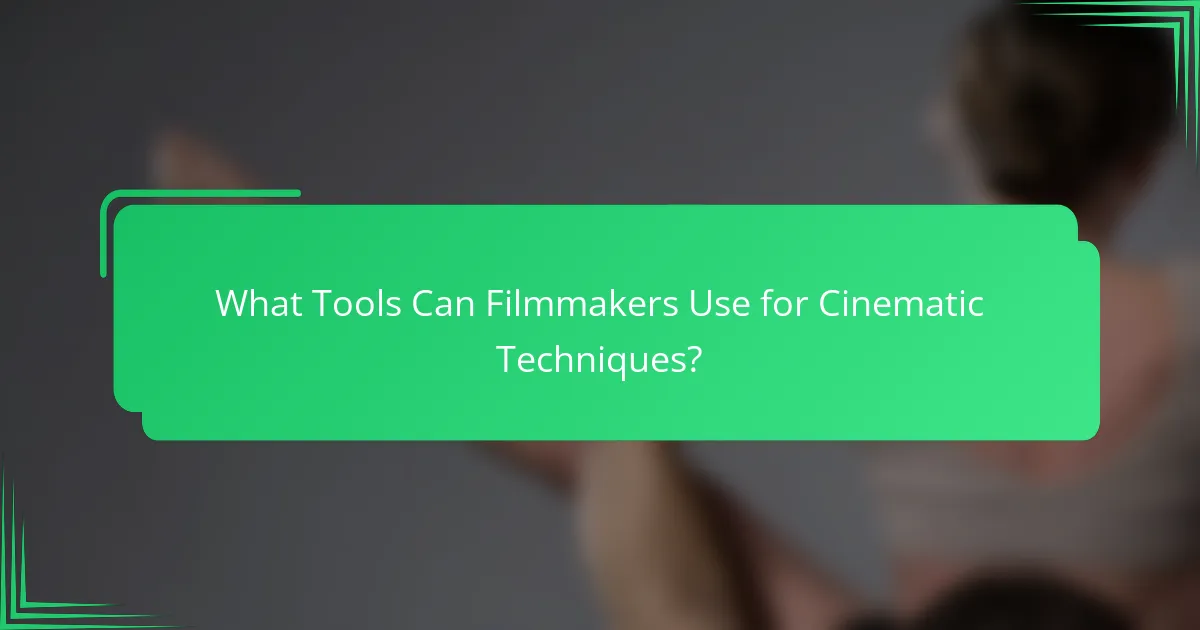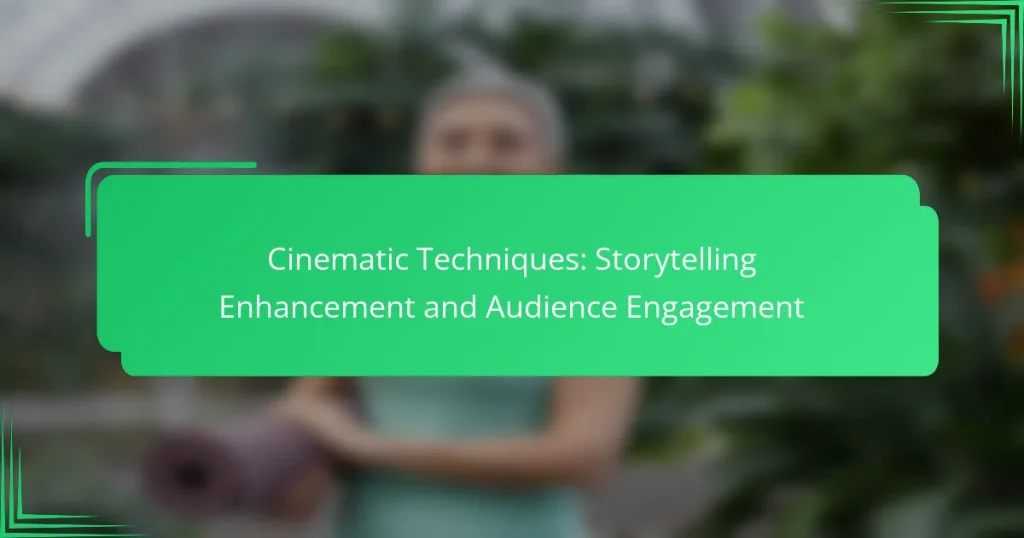Cinematic techniques play a crucial role in enhancing storytelling by crafting immersive experiences that resonate with audiences on both emotional and intellectual levels. By employing elements such as visuals, pacing, and sound design, filmmakers can deepen narratives and foster a stronger connection between viewers and the story. In 2023, innovative methods like dynamic camera movements and non-linear narratives continue to evolve, enriching the overall viewing experience.

How Do Cinematic Techniques Enhance Storytelling?
Cinematic techniques enhance storytelling by creating immersive experiences that engage audiences emotionally and intellectually. These techniques, such as visuals, pacing, framing, and symbolism, work together to deepen the narrative and strengthen the connection between the viewer and the story.
Emotional engagement through visuals
Visuals play a crucial role in evoking emotions and establishing the tone of a film. By using color palettes, lighting, and composition, filmmakers can create specific moods that resonate with the audience. For instance, warm colors may convey comfort, while cooler tones can evoke sadness or tension.
Close-up shots of characters’ faces can intensify emotional moments, allowing viewers to connect with their feelings. This technique is often used in dramatic scenes to highlight vulnerability or conflict, making the audience feel more invested in the characters’ journeys.
Building tension with pacing
Pacing is essential for maintaining suspense and engaging the audience throughout a film. By manipulating the speed of scenes, filmmakers can create a sense of urgency or calm, depending on the narrative needs. Quick cuts during action sequences can heighten excitement, while slower pacing in dramatic moments allows for reflection.
Effective pacing often involves a balance between fast and slow sequences. For example, alternating between high-energy scenes and quieter moments can keep viewers on the edge of their seats while providing necessary breaks for emotional processing.
Character development via framing
Framing is a powerful tool for character development, as it influences how audiences perceive and relate to characters. The way a character is positioned within a shot can suggest their emotional state or relationship to others. For instance, a character framed alone in a wide shot may appear isolated, while being framed closely with another character can indicate intimacy.
Using different angles can also convey power dynamics. A low-angle shot can make a character appear dominant, while a high-angle shot can suggest vulnerability. These visual cues help to build a more complex understanding of characters and their motivations.
Symbolism and thematic depth
Symbolism adds layers of meaning to a story, allowing filmmakers to convey complex themes without explicit dialogue. Objects, colors, or recurring motifs can represent broader concepts, enriching the narrative. For example, a recurring image of a clock might symbolize the passage of time and its impact on the characters’ lives.
Incorporating symbolism requires careful consideration to ensure it resonates with the audience. Filmmakers should aim for subtlety, allowing viewers to interpret symbols in their own way, which can lead to deeper engagement with the film’s themes and messages.

What Techniques Improve Audience Engagement?
Techniques that enhance audience engagement include sound design, interactive storytelling, and virtual reality (VR) experiences. These methods create a more immersive and participatory environment, allowing viewers to connect with the narrative on a deeper level.
Use of sound design
Sound design plays a crucial role in audience engagement by enhancing the emotional tone and atmosphere of a film or show. Effective soundscapes can evoke feelings, create tension, or provide cues that guide viewers’ reactions. For instance, subtle background sounds can enrich scenes, while sudden audio shifts can heighten suspense.
When implementing sound design, consider the balance between dialogue and ambient sounds. Too much noise can overwhelm viewers, while too little can make scenes feel flat. Aim for a harmonious blend that supports the storytelling without distracting from it.
Interactive storytelling methods
Interactive storytelling engages audiences by allowing them to influence the narrative direction. This can be achieved through branching storylines, where choices lead to different outcomes, or through audience participation in live performances. Such methods foster a sense of agency, making viewers feel more invested in the story.
To effectively utilize interactive storytelling, ensure that choices are meaningful and impact the narrative in significant ways. Avoid overwhelming the audience with too many options; instead, focus on a few key decisions that enhance the overall experience.
Audience immersion through VR
Virtual reality (VR) offers a unique way to immerse audiences in a story by placing them directly within the narrative environment. This technology allows viewers to explore settings and interact with characters, creating a sense of presence that traditional media cannot achieve. For example, VR experiences can transport users to fantastical worlds or historical events, making them feel like active participants.
When designing VR content, prioritize user comfort and intuitive controls. Ensure that experiences are accessible and not overly complex, as this can detract from immersion. Additionally, consider the length of VR sessions; keeping them within a reasonable time frame can help maintain engagement without causing fatigue.

Which Cinematic Techniques Are Most Effective in 2023?
In 2023, effective cinematic techniques focus on enhancing storytelling and engaging audiences through innovative methods. Key techniques include dynamic camera movements, non-linear narrative structures, and color grading that sets the mood, each contributing uniquely to the viewing experience.
Dynamic camera movements
Dynamic camera movements involve using techniques like tracking shots, handheld filming, and crane shots to create a sense of immersion. These movements can evoke emotions, guide the audience’s attention, and enhance the overall storytelling. For instance, a sweeping crane shot can establish the scale of a scene, while a shaky handheld shot can convey urgency or chaos.
When implementing dynamic camera movements, consider the pacing and rhythm of your scene. Rapid movements can increase tension, while slower, deliberate movements can build suspense. Avoid overusing these techniques, as they can distract from the narrative if not executed thoughtfully.
Non-linear narrative structures
Non-linear narrative structures break away from traditional storytelling by presenting events out of chronological order. This technique can create intrigue and allow for deeper character exploration, as viewers piece together the story from various timelines. Films like “Pulp Fiction” and “Memento” exemplify how this approach can enhance engagement.
To effectively use a non-linear structure, ensure that each segment contributes meaningfully to the overall narrative. Consider using visual cues or thematic elements to help guide the audience through the timeline shifts. Be cautious of confusing viewers; clarity should remain a priority even in complex narratives.
Color grading for mood
Color grading is the process of adjusting the colors and tones in a film to evoke specific emotions and set the mood. For example, warmer tones can create a sense of comfort, while cooler tones may evoke sadness or tension. This technique can significantly influence how audiences perceive a story and its characters.
When applying color grading, think about the emotional journey of your film. Use color palettes that align with the themes and character arcs. Avoid excessive or inconsistent color grading, as it can detract from the viewer’s experience and undermine the intended mood. A well-thought-out color scheme can enhance storytelling and deepen audience engagement.

What Are the Prerequisites for Implementing These Techniques?
To effectively implement cinematic techniques that enhance storytelling and engage audiences, filmmakers must first understand their audience and budget constraints. These factors play a crucial role in determining the feasibility and impact of various techniques.
Understanding audience demographics
Knowing your audience demographics is essential for tailoring cinematic techniques to their preferences. Factors such as age, gender, cultural background, and viewing habits influence how viewers interpret and connect with a story.
For instance, younger audiences may prefer fast-paced editing and vibrant visuals, while older viewers might appreciate slower storytelling and character development. Conducting surveys or analyzing viewer data can provide insights into these preferences.
Budget considerations for production
Budget constraints significantly affect the choice and implementation of cinematic techniques. High-quality visual effects, elaborate sets, and professional talent can require substantial financial investment, which may not be feasible for all projects.
Filmmakers should prioritize techniques that align with their budget while still achieving the desired emotional impact. For example, using practical effects instead of CGI can save costs while enhancing authenticity. A clear budget plan can help in making informed decisions about which techniques to pursue.

How Do Different Genres Utilize Cinematic Techniques?
Different genres employ cinematic techniques to enhance storytelling and engage audiences in unique ways. By understanding these techniques, filmmakers can effectively convey emotions, build tension, or create humor, tailoring their approach to fit the genre’s conventions.
Dramatic techniques in thrillers
Thrillers often use suspenseful pacing and visual framing to heighten tension and keep viewers on the edge of their seats. Techniques such as close-ups can emphasize a character’s fear or anxiety, while quick cuts can create a sense of urgency during critical moments.
Common elements include the use of dark lighting and shadow to evoke a sense of danger, as well as sound design that incorporates sudden noises or silence to amplify suspense. Filmmakers should consider the emotional impact of each scene and how these techniques can manipulate audience reactions.
Comedy timing and visual gags
In comedy, timing is crucial; the delivery of a punchline often relies on precise pacing and rhythm. Visual gags, such as slapstick humor or exaggerated expressions, can enhance comedic effect and engage the audience through unexpected surprises.
Filmmakers should focus on the interplay between dialogue and visual elements, ensuring that comedic moments are well-timed and clearly presented. Utilizing techniques like slow motion or reaction shots can help emphasize the humor and make it more relatable to viewers.

What Tools Can Filmmakers Use for Cinematic Techniques?
Filmmakers utilize various tools and techniques to enhance storytelling and engage audiences effectively. These tools range from camera angles and lighting to sound design and editing, each contributing to the overall narrative experience.
Camera Angles and Movement
Camera angles and movement are crucial for shaping how a story is perceived. Different angles, such as high, low, or eye-level shots, can evoke specific emotions or perspectives. For instance, a low-angle shot can make a character appear powerful, while a high-angle shot can suggest vulnerability.
Camera movement, including pans, tilts, and tracking shots, adds dynamism to scenes. A smooth tracking shot can immerse viewers in the action, while abrupt cuts can create tension. Filmmakers should consider the emotional tone of the scene when choosing camera techniques.
Lighting Techniques
Lighting plays a vital role in setting the mood and tone of a film. Natural light can create a realistic atmosphere, while artificial lighting allows for more control over the scene’s emotional impact. Techniques like three-point lighting help to highlight subjects and create depth.
Filmmakers should experiment with shadows and colors to enhance storytelling. For example, warm lighting can evoke feelings of comfort, while harsh lighting may create a sense of unease. Understanding the psychological effects of lighting can significantly influence audience engagement.
Sound Design
Sound design encompasses dialogue, sound effects, and music, all of which contribute to the film’s emotional landscape. Effective sound design can heighten tension, evoke nostalgia, or provide comic relief. Filmmakers should aim for a balanced mix that complements the visuals.
Using diegetic sounds (sounds that originate from the film’s world) and non-diegetic sounds (like background music) strategically can enhance storytelling. For instance, a sudden silence can create suspense, while an uplifting score can signal a moment of triumph.
Editing Techniques
Editing is essential for pacing and narrative structure. Techniques such as cross-cutting, montage, and jump cuts can manipulate time and space, guiding the audience’s emotional journey. Effective editing ensures that the story flows smoothly and maintains viewer interest.
Filmmakers should be mindful of the rhythm created by editing choices. Quick cuts can build excitement, while longer takes can allow for reflection. A well-edited film balances these techniques to enhance storytelling without overwhelming the audience.


